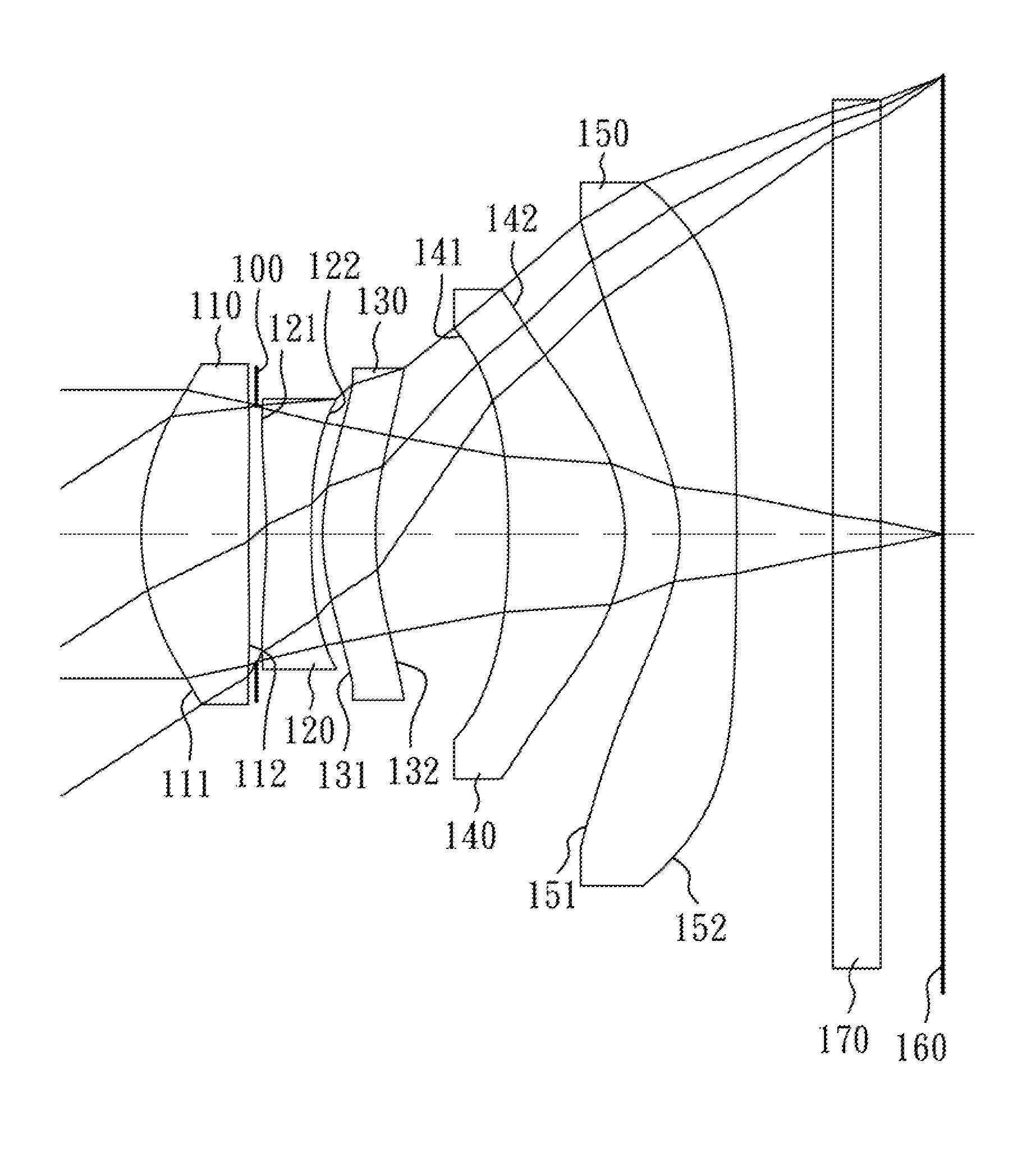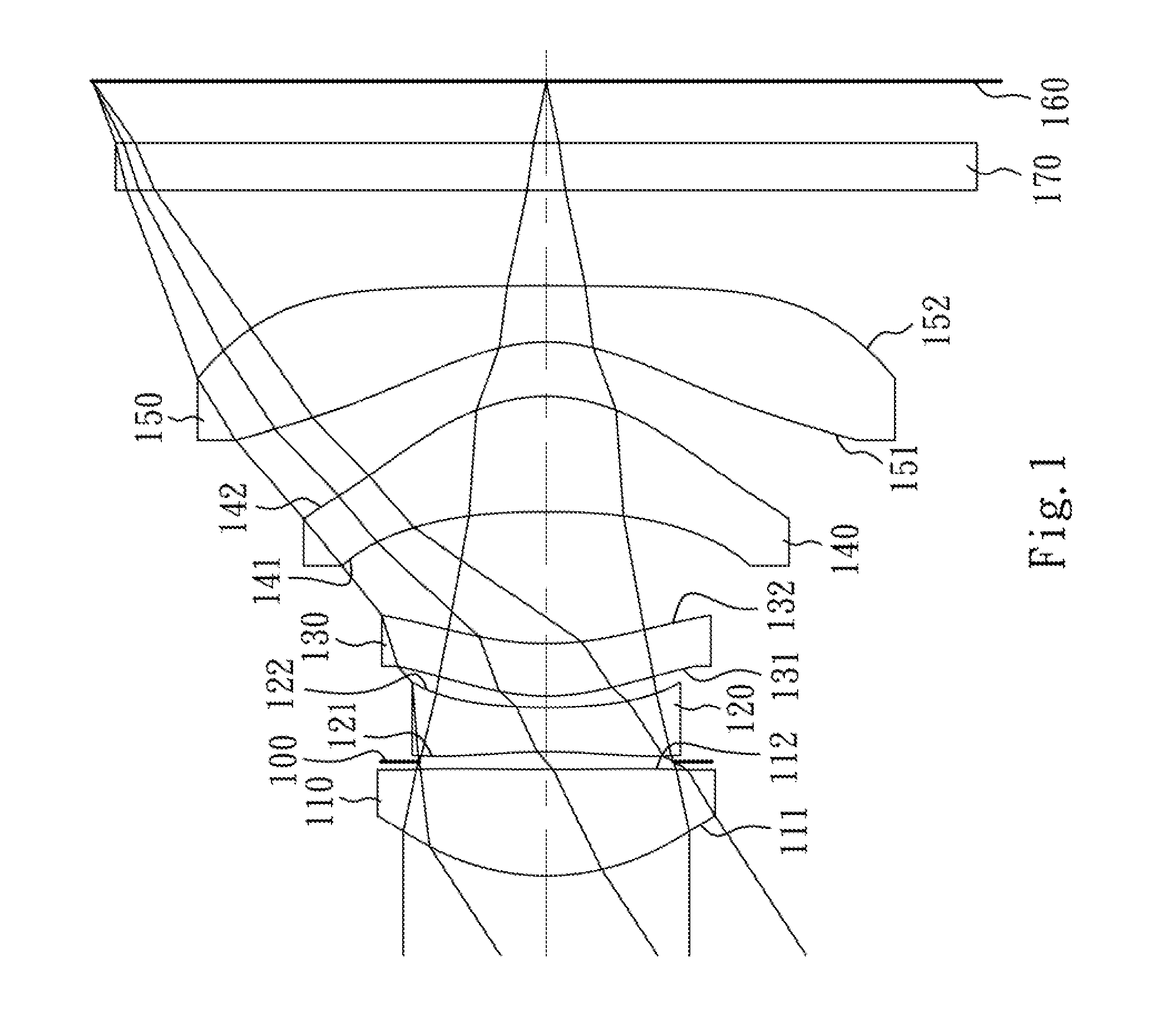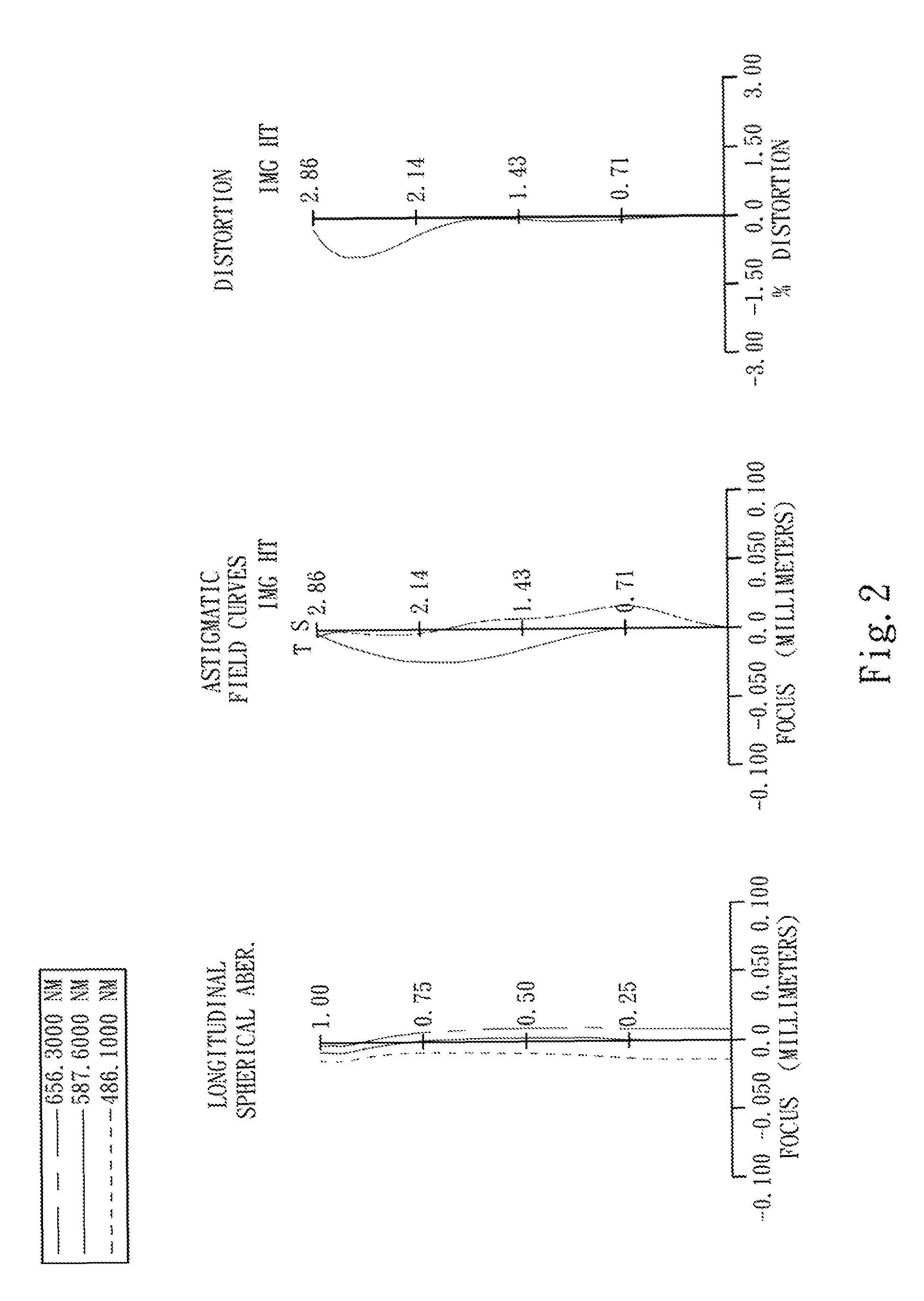Image capturing optical lens assembly
a technology of optical lens and assembly, applied in the field of can solve the problem that the conventional four-piece lens structure cannot meet the requirements of the compact image capture optical lens assembly
- Summary
- Abstract
- Description
- Claims
- Application Information
AI Technical Summary
Benefits of technology
Problems solved by technology
Method used
Image
Examples
first embodiment
[0059]The equation of the aspheric surface profiles of the aforementioned lens elements of the first embodiment is expressed as the following:
[0060]X(Y)=(Y2 / R)(1+sqrt(1-(1+k)×(Y / R)2))+∑i(Ai)×(Yi)
[0061]where:
[0062]X is the height of a point on the aspheric surface spaced at a distance Y from the optical axis relative to the tangential plane at the aspheric surface vertex;
[0063]Y is the distance from the point on the curve of the aspheric surface to the optical axis;
[0064]R is the curvature radius of the surface of the lens element;
[0065]k is the conic coefficient; and
[0066]Ai is the i-th aspheric coefficient.
[0067]In the image capturing optical lens assembly according to the first embodiment, when f is a focal length of the image capturing optical lens assembly, Fno is an f-number of the image capturing optical lens assembly, and HFOV is half of the maximal field of view, these parameters have the following values:
[0068]f=4.40 mm;
[0069]Fno=2.45; and
[0070]HFOV=33.1 degrees.
[0071]I...
second embodiment
[0091]The detailed optical data of the second embodiment are shown in Table 3 and the aspheric surface data are shown in Table 4 below.
[0092]
TABLE 32nd Embodimentf = 4.71 mm, Fno = 2.50, HFOV = 31.3 deg.CurvatureFocalSurface #RadiusThicknessMaterialIndexAbbe #length0ObjectPlanoInfinity1Lens 1 1.600710 (ASP)0.639Plastic1.54455.93.632 7.258000 (ASP)0.0943Ape. StopPlano0.0684Lens 2 −2.767940 (ASP)0.270Plastic1.63423.8−5.205−17.962300 (ASP)0.0466Lens 3 1.165350 (ASP)0.327Plastic1.54455.913.947 1.240700 (ASP)0.9378Lens 4 −5.310600 (ASP)0.801Plastic1.54455.92.499 −1.138110 (ASP)0.38710Lens 5 −1.158020 (ASP)0.330Plastic1.54455.9−2.4111−10.729600 (ASP)0.60012Cover-GlassPlano0.300Glass1.51764.2—13Plano0.48414ImagePlano—Note:Reference wavelength (d-line) is 587.6 nm.
[0093]
TABLE 4Aspheric CoefficientsSurface #12456k =−9.00023E−01−6.75424E+01−4.28943E+01−1.00000E+00−6.10502E+00A4 =9.78877E−03−6.73365E−021.05680E−012.46695E−011.05143E−01A6 =−7.66527E−03−7.53313E−02−9.14044E−02−3.38592E−02−1.4854...
third embodiment
[0104]The detailed optical data of the third embodiment are shown in Table 5 and the aspheric surface data are shown in Table 6 below.
[0105]
TABLE 53rd Embodimentf = 4.22 mm, Fno = 2.50, HFOV = 34.1 deg.FocalSurface #Curvature RadiusThicknessMaterialIndexAbbe #length0ObjectPlanoInfinity1Ape. StopPlano−0.244 2Lens 1 1.532120 (ASP)0.608Plastic1.54455.92.593−14.858800 (ASP)0.1184Lens 2 −5.518200 (ASP)0.265Plastic1.63423.8−2.525 2.293370 (ASP)0.1046Lens 3 1.593220 (ASP)0.299Plastic1.63423.86.807 2.342150 (ASP)0.6908Lens 4 −6.166000 (ASP)0.877Plastic1.54455.92.279 −1.082080 (ASP)0.43110Lens 5 −1.043860 (ASP)0.320Plastic1.53556.3−2.1111−15.748000 (ASP)0.60012Cover-GlassPlano0.300Glass1.51764.2—13Plano0.28714ImagePlano—Note:Reference wavelength (d-line) is 587.6 nm.
[0106]
TABLE 6Aspheric CoefficientsSurface #23456k =−5.32692E−01−1.00000E+00−5.22131E+01−2.91791E+01−1.28702E+01A4 =2.07819E−021.14874E−012.00311E−012.35787E−017.86979E−02A6 =2.02691E−02−8.36693E−02−1.97508E−01−1.30128E−01−1.09142...
PUM
 Login to View More
Login to View More Abstract
Description
Claims
Application Information
 Login to View More
Login to View More - R&D
- Intellectual Property
- Life Sciences
- Materials
- Tech Scout
- Unparalleled Data Quality
- Higher Quality Content
- 60% Fewer Hallucinations
Browse by: Latest US Patents, China's latest patents, Technical Efficacy Thesaurus, Application Domain, Technology Topic, Popular Technical Reports.
© 2025 PatSnap. All rights reserved.Legal|Privacy policy|Modern Slavery Act Transparency Statement|Sitemap|About US| Contact US: help@patsnap.com



